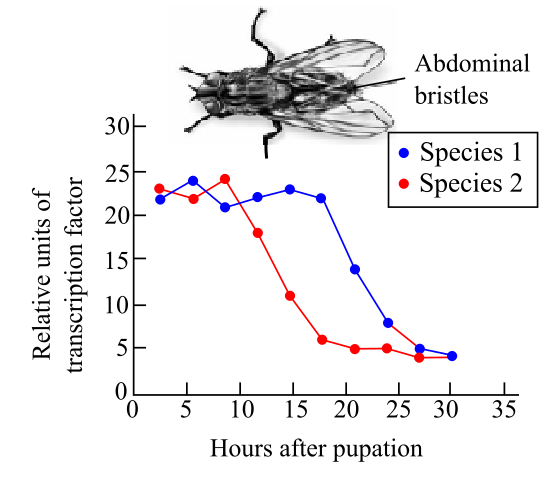
To review:
The results and formulate a hypothesis for the role of a transcription factor in the two species. Also, assess whether it is an example of heterometry, heterotropy, or heterochrony.
Introduction:
Transcription factors are the proteins involved in the process of transcribing the DNA (deoxyribonucleic acid) molecules into RNA (ribonucleic acid). These factors can repress or activate transcription to regulate expression of a gene within a cell of an organism.
Heterometry is referred to the change in the amount of gene expression during the developmental stages of an organism. Heterotropy is termed as the evolutionary change in the spatial pattern of development. Heterochrony is defined as the change in gene expression timings and developmental rates of an organism. The figure shows the gene expression pattern for both species 1 and 2 over the course of time.

Figure: Change in relative units of a transcription factor with time.
Explanation of Solution
It can be clearly observed from the above figure that the two species are relatively different in terms of the duration of time taken for a transcription factor to remain high. In species 1, the duration of gene expression remains longer in comparison to the expression of a transcription factor in species 2. Thus, it is an example of heterochrony due to the differences in their timing of transcription factor’s expression.
Thus, it can be hypothetically stated that the differential timing of expression of the transcription factor causes the morphological difference between species 1 and 2. A longer period of high transcription factor’s expression in species 1 specifically leads to longer abdominal bristles in that species.
Thus, it can be concluded that the species 1 have a longer time of expression of a transcription factor as compared to species 2 and this an example of heterochrony. The morphological differences occur between the two species due to the difference in the timing of expression of the transcription factors.
Want to see more full solutions like this?
Chapter 19 Solutions
Life: The Science of Biology
- Propose a hypothesis that could explain the following observation. A graduate student performing studies on mutations in drosophila (fruit flies) discovered a strain of flies with a silent mutation in the gene controlling the shape of the wings. Further investigation has shown that this mutation is lethal in flies who are homozygote. Flies that are homozygote wild type or heterozygote can develop and are able to survive.arrow_forwardCreate a Venn diagram to compare and contrast the process of gene expression in Bacteria versus eukaryotes. Remember that “gene expression” can include any part of transcription or translation. Try to be as thorough as you can about what aspects of this process are similar between the two taxa, and what characteristics are distinct to only Bacteria or eukaryotes. Plase include a minimum of 15 items in the Venn diagram.arrow_forwardConsider the diagram below and answer the following questions: The image shows [Select] chromosome(s). • How many chromosomes are shown in the image? [Select] Which term best describes what is shown by the bracket labeled "a"? [Select] D If the image does not load, make sure you are using Chrome and then refresh your browser.arrow_forward
- Small chromosomal duplications provide raw material for the addition of genes into a species' genome. These duplications create two or more copies of the same gene, where one or both of the genes can subsequently mutate. These genes are referred to as O homologous genes. O transposable elements. O sister chromatids.arrow_forwardGive only typing answer with explanation and conclusion What is the locus specific rate of substitution for two lineages that separated 12,963,786 year ago and differ at 25 of 878 nucleotides.arrow_forwardPick the statement about chromosome structure that is FALSE. Gene duplications provide an explanation for the origin of gene families. A position effect occurs when a gene’s expression is altered by virtue of a change in its chromosomal position. Inversions decrease the frequency of recombinate gametes. A paracentric inversion is one whose break points include the centromere. Genes that function abnormally when present in only one copy are called haploinsufficient.arrow_forward
- Diagram how mispairing of homologous chromosomes could have led to the formationof a gene that codes for a protein that has 2 domains. Explain how two geneswhich were separate coding units became 1 gene with one coding unit. Why are theproducts of this cross over event called non-reciprocal cross over products?arrow_forwardconsider the metaphase (mitosis) chromosome spread of the following related animal species. The first meiotic division in the hybrid animal shows a mixture of paired and single chromosomes. Why do you suppose this occurs? Can you suggest a possible relationship between the mixed chromosomes and the observed sterility of the hybrid?arrow_forwardCreate a dichotomous key pleasearrow_forward
- You are working with two different yeast cultures to study their genetics. But, you are not sure what the mating type of either of the yeast cultures is. (As a reminder, yeast mating types are either a or alpha). As a test, you mix the two cultures together and then observe them under a microscope. If this is the image that you see, what can you conclude about the mating types of the yeast? Explain your answer, including what type of cell morphology you see on this microscope slide.arrow_forwardExplain whether the statement "The normal gene function is required for the viability of the zebrafish." is true, or falsearrow_forwardConstruct a map showing the distant and order of all genes (a-e)arrow_forward

 Biology (MindTap Course List)BiologyISBN:9781337392938Author:Eldra Solomon, Charles Martin, Diana W. Martin, Linda R. BergPublisher:Cengage Learning
Biology (MindTap Course List)BiologyISBN:9781337392938Author:Eldra Solomon, Charles Martin, Diana W. Martin, Linda R. BergPublisher:Cengage Learning

